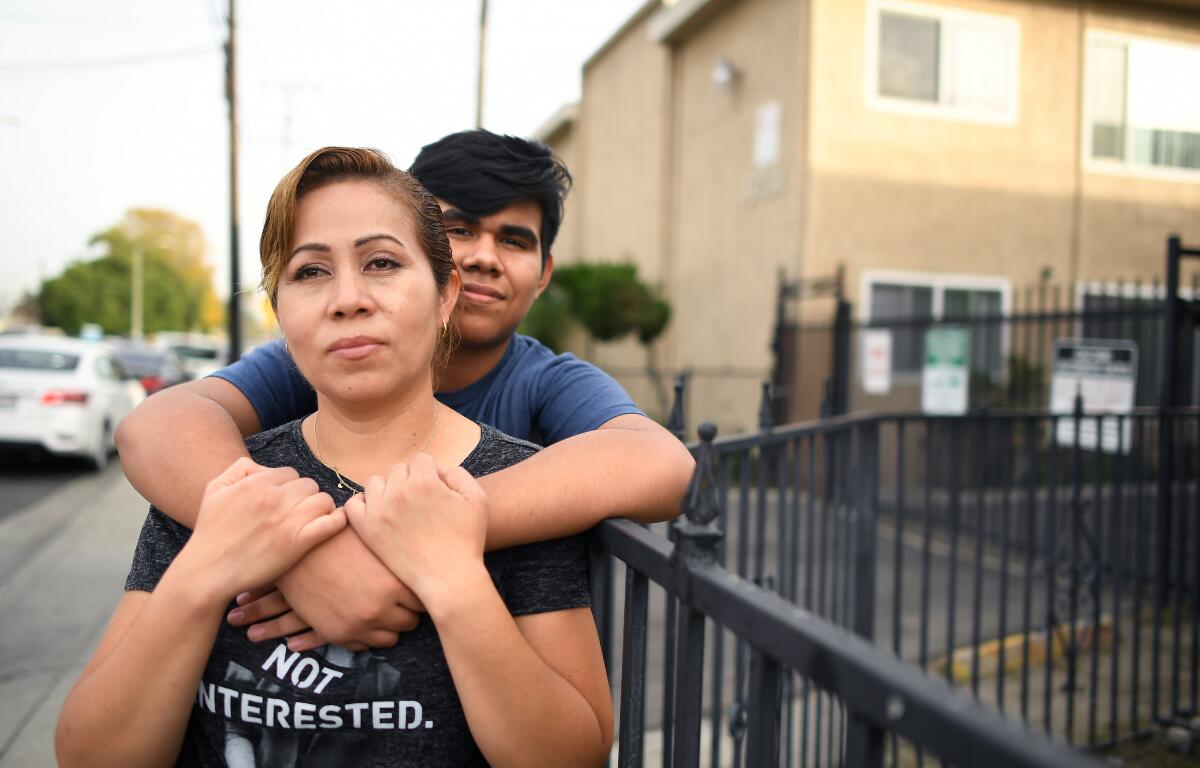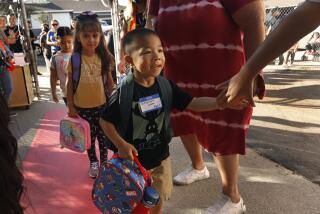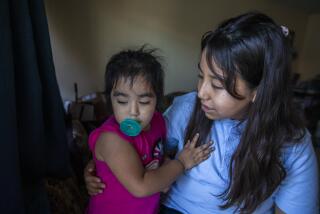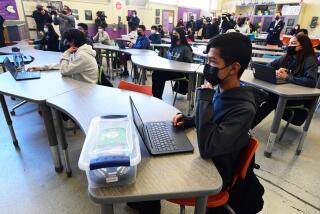When schools reopen will you send your child back?

- Share via
Amid anxieties over online learning and a dangerous surge in coronavirus cases, Los Angeles Unified School District parents are being asked in a new survey to make a critical decision: Will you send your child back to school when campuses reopen?
The inopportune timing — as health authorities describe dark scenarios about the weeks ahead — is unavoidable. L.A. Unified, like districts throughout the state, must brace for the worst: the possibility of another hard shutdown of campuses. But they must also simultaneously prepare for the complex task of fully reopening campuses that have been closed for 10 months.
The survey, which must be returned by Sunday, is expected to provide the first comprehensive data on where the parents of some 465,000 students stand amid a growing debate over school safety and the extent to which political leaders are prioritizing the importance of reopening campuses.
Parents in the nation’s second-largest school district are being asked on a very personal level to weigh the same issues confounding health experts, educators and political leaders: How safe are schools? What are the risks? What’s best for my child?
Whether or not to return is “a loaded question with a lot of implications,” said Vanessa Aramayo, executive director of the local nonprofit Alliance for a Better Community. “It’s extremely difficult for the families we work with because of what’s at stake.”
Underlying the choice are myriad anxieties, unknowns and trade-offs: Evidence continues to mount that distance-only learning is harmful to many students and exacerbates gaps separating richer and poorer families, and white and Asian students from Black and Latino students. Distance learning also limits the ability of parents to work. Yet no one wants to compromise safety amid the COVID-19 pandemic.
“I am worried that once children return to school they might bring the virus home, and those at higher risk, such as the adults and the older folks, might contract the virus,” said Yesica Aguirre, whose eighth-grade son attends Bell Gardens Middle School.
Her 62-year-old husband recently had heart surgery, putting him in a high-risk group. Other family members outside their household came down with COVID-19 “and they were all very sick,” Aguirre said.
Her son Adrian enjoys being online and fares well in distance learning, but at the same time, Aguirre said, “I understand that it’s best to do in-person classes because the students get to interact with the teacher and because they also get to socialize.”
No one knows exactly when L.A. Unified will resume in-person classes, and officials have no estimated opening date. But the math does not look promising in Los Angeles County for a return to school after winter break in January.
Under California’s rules, campuses cannot fully reopen in any county until two weeks after it exits the purple tier of the state’s color-coded reopening framework — which indicates widespread and dangerous levels of virus transmission. Given the alarming surge of cases, L.A. County could be in the purple tier well into next year. And even then, L.A. Unified would have the option to wait longer if district officials deem it advisable.
The status of partial campus reopenings across the county is uneven. Some districts and schools have used waivers to bring back students in transitional kindergarten through second grade. And some are bringing back students of all ages with special needs, up to 25% of enrollment at a given time.
Across the country, large numbers of parents have landed on each side of the question. And school systems have responded by offering two or more simultaneous programs, with varying degrees of success.
In New York City — the nation’s largest school system — the families of about 30% of students have opted for in-person learning. But the start of the school year was ultimately pushed back because of logistical problems — and then a virus surge led to another shutdown. The wild ride continues with a limited reopening for elementary schools scheduled to begin next week.
Over the summer, a majority of Boston parents said they wanted campuses to reopen in some form, but a gradual reopening was temporarily shelved in late October when infections spiked. Florida forced school districts to reopen, but many families chose to remain online, and it’s difficult to get a clear picture of the public health effects of the mandated reopening.
Research from Brown University economist Emily Oster strongly suggests that schools are not super-spreaders of the coronavirus — finding that the infection rates in schools were similar to those in the community and could even be lower. A study from Yale drew similar conclusions about child care centers.
But there are caveats. Oster’s conclusions were based on voluntary participation from school districts that were confident in their safety measures and that disproportionately represent higher-income communities with lower infection rates.
In a recent webinar, Oster questioned whether it would make sense to open campuses when community infection rates are high. In that circumstance, keeping schools from spreading infection might still be manageable but also might prove overly disruptive to academic continuity — because preventing an outbreak could require groups of students to be sent home frequently to quarantine.
L.A. schools Supt. Austin Beutner, who has pursued a cautious approach to reopening, has cited a study of Utah child care centers — where researchers found evidence of transmission from child to child and from child to adult household members.
Inconsistent record-keeping at the local, state and federal levels has made it difficult to draw definitive conclusions — a fundamental reason why Oster said she made her own attempt. That’s also why teachers unions have pushed back against rapid reopenings, especially as they hear tales of school shutdowns and school-based infections from colleagues across the country. These anecdotes are more than enough to cause worry, even if they prove to be rare.
UNICEF, the Untied Nations’ children’s relief agency, and experts including leading U.S. immunologist Dr. Anthony Fauci have come down for reopening campuses — especially for younger students.
In an interview on ABC’s “This Week,” Fauci said that spread “among children and from children is not really very big at all, not like one would have suspected. So let’s try to get the kids back.”
Infections among people with an association to schools soared in November, L.A. County health officials reported Wednesday. Public Health Director Barbara Ferrer indicated that the school cases seem to reflect the overall surge in the community rather than infections driven by individuals on campus.
L.A. County has recorded 21 schools with an outbreak investigation — defined as three or more cases over 14 days. Four of nearly 1,400 schools in L.A. Unified are on this list. All the recorded cases of possible outbreaks have involved only staff members, with a maximum of four infections. Many more schools have had one or two cases. New rules in Los Angeles County call for a two-week campus shutdown when there’s an outbreak.
So far, few people have been on any L.A. Unified campus. The vast majority of teachers are working from home, and only 2,275 students — fewer than 1% — are coming to campus periodically for individual or small-group tutoring, and that effort began only recently.
The L.A. Unified survey gives parents two choices: continue in distance-only learning or switch to a hybrid format — which would bring smaller groups of students to campus part time on a staggered schedule. When not on campus, students would attend classes online. Parents can change their mind at any time to switch to distance-only. To transfer to the hybrid model, they would have to wait until designated entry dates.
Families that don’t respond will be assigned to a hybrid setting, which concerns some advocacy groups. They insist that the district needs to work harder to make sure all families know about the survey and have enough information to make the choice that’s best for them.
The survey also gathers input on a public policy choice made by state and local officials — allowing businesses to open ahead of schools.
The survey asks: “Would you support increased restrictions on certain businesses like malls and card rooms if that meant schools could reopen?”
In recent months, almost all businesses have been able to operate with more freedom than schools — though businesses, too, have suffered deep harm. Some countries, including France, Spain and Belgium, have closed or limited operations for businesses and other entities but prioritized opening schools and keeping them open, an approach being echoed in Rhode Island.
Beutner doesn’t propose opening schools during the current surge — and he generally supports strict health directives. But he’s said that schools should be prioritized when officials are deciding what to open first.
Aguirre, the parent of the eighth-grader, already has dealt with one scare in her household. Her adult son, who is living at her home, caught something from a friend and lost his sense of taste and smell for two weeks. They all knew it was probably COVID-19.
“My son was in isolation,” she said. “Everyone at home wore masks and gloves, and we kept cleaning all the time. I even slept with my mask on to protect my husband. We’re worried about what is going to happen, if we are going to die. It really affects us psychologically.”
But she also said that, for now, her choice is to return to campus and to trust in God.
“Our lives need to continue, and we cannot stay indoors for a long time,” she said. “And I would hope that the schools will provide the necessary safety precautions.”
More to Read
Sign up for Essential California
The most important California stories and recommendations in your inbox every morning.
You may occasionally receive promotional content from the Los Angeles Times.














